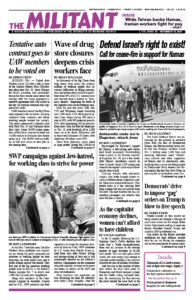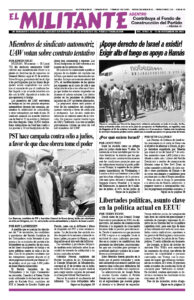As thousands of the Big Three chain drug stores close across the country, millions of working people face increased difficulties in filling prescriptions and getting other medical supplies. More than 40% of all U.S. counties have now become what is known as “pharmacy deserts,” deepening the blows of the capitalist crisis on the working class.
Over the past two years, Rite Aid, CVS and Walgreens began shuttering over 1,500 stores. CVS, the largest drugstore chain, began closing 300 stores a year in 2021, with 900 projected gone by 2024, after eliminating 244 the previous three years. Rite Aid filed for bankruptcy Oct. 15, with hundreds of its 2,200 stores set to be closed. Walgreens said in June it will eliminate 150 stores, after shuttering 200 others since 2019.
These three pharmacy giants raked in huge profits during the COVID-19 pandemic in handouts from the government for giving vaccine shots.
In addition, the chains have faced hundreds of lawsuits over their role in over-dispensing opioids, which contributed to the overdose deaths of more than 300,000 people since 2000.
In response to deteriorating work conditions as drug-store bosses implement “cost saving” measures, pharmacists and technicians at more than 500 Walgreens stores around the country went on strike Oct. 9-11. They were protesting understaffing, speedup and low pay. Similar protests took place at CVS stores in Kansas City, Missouri, the month before. On Oct. 30, pharmacy workers at Walgreens and CVS in several states began another three-day walkout.
The drug-store closures have the biggest impact in small towns and rural areas. Many towns across the Midwest and the southern part of the U.S. are at least 10 miles — and often much farther — away from the nearest pharmacy. Nearly 200 rural hospitals have been shut down since 2005, with hundreds more on the chopping block.
The pharmacy closures make it much more difficult for older adults, many of whom require a number of medications, to get them.
In the 1990s and early 2000s, CVS and Walgreens moved into cities and towns, using their sheer size to crush independent local pharmacies. Nearly 50% of these outlets have disappeared in the past four decades. They’re no longer available as an alternative as the retail giants are closing down.
Class-divided capitalist crisis
The effects of today’s deepening capitalist economic crisis are sharply class-divided. While the ruling rich are spending like there is no tomorrow, working people are tightening their belts. This means all claims by the government that the economy is booming are a lie for the vast majority of us.
More than 44.2 million people lived in households that struggled with hunger last year, the U.S. Department of Agriculture had to admit, an increase of 10.3 million over the previous year. This affected 13.4 million children in lower-paid working-class families. Fully one-third of single-parent households headed by women don’t have enough food.
This crisis was exacerbated when state and federal governments closed down pandemic programs last year that provided free school meals to families during the first two years of school and emergency funds from the Supplemental Nutrition Assistance Program.
“Our food banks across the country have been reporting exceedingly high demand,” Claire Babineaux-Fontenot, chief executive of Feeding America, told the Washington Post, with “50 million visitors last year and about close to that this year — a third more than before the pandemic.”
With food prices rising and real wages declining, increasing numbers of workers are also struggling to cover monthly rent.
With interest on home mortgages reaching nearly 8%, the average monthly house payment is now 52% higher than it costs to rent an apartment — even though rents have soared 22% over the past three years. This situation makes it more difficult for young people to move out of living with their parents or other relatives and to get their own place to have and raise a family.
While many workers are forced to retrench to make ends meet, the bosses, bankers, graft-enriched politicians and upper-middle-class layers, who’ve amassed hoards of funds, are spending big time.
This includes splurges on $40,000 watches, private planes, bloated concert ticket prices, private suites at sports events, fancy vacations and other baubles.
To service this lucrative market, the Financial Times publishes a weekly high-end ad-crammed glossy magazine called “How to Spend It.” The Oct. 29 New York Times included a special magazine entirely devoted to high-end watches.
But under this class-divided capitalist system, workers face an entirely different reality. These conditions — exacerbated by boss attacks on wages and working conditions — have fueled strikes by autoworkers, hospital workers and more. And they feed a discussion among workers today over the need to break from the rulers’ main parties — the Democrats and Republicans.

